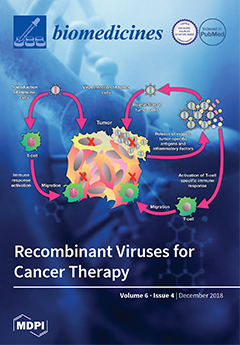The human body is naturally colonized by a huge number of different commensal microbial species, in a relatively stable equilibrium. When this microbial community undergoes dysbiosis at any part of the body, it interacts with the innate immune system and results in a
[...] Read more.
The human body is naturally colonized by a huge number of different commensal microbial species, in a relatively stable equilibrium. When this microbial community undergoes dysbiosis at any part of the body, it interacts with the innate immune system and results in a poor health status, locally or systemically. Research studies show that bacteria are capable of significantly influencing specific cells of the immune system, resulting in many diseases, including a neoplastic response. Amongst the multiple different types of diseases, pancreatic cancer and liver cirrhosis were significantly considered in this paper, as they are major fatal diseases. Recently, these two diseases were shown to be associated with increased or decreased numbers of certain oral bacterial species. These findings open the way for a broader perception and more specific investigative studies, to better understand the possible future treatment and prevention. This review aims to describe the correlation between oral dysbiosis and both pancreatic cancer and liver cirrhotic diseases, as well as demonstrating the possible diagnostic and treatment modalities, relying on the oral microbiota, itself, as prospective, simple, applicable non-invasive approaches to patients, by focusing on the state of the art. PubMed was electronically searched, using the following key words: “oral microbiota” and “pancreatic cancer” (PC), “liver cirrhosis”, “systemic involvement”, and “inflammatory mediators”. Oral dysbiosis is a common problem related to poor oral or systemic health conditions. Oral pathogens can disseminate to distant body organs via the local, oral blood circulation, or pass through the gastrointestinal tract and enter the systemic circulation. Once oral pathogens reach an organ, they modify the immune response and stimulate the release of the inflammatory mediators, this results in a disease. Recent studies have reported a correlation between oral dysbiosis and the increased risk of pancreatic and liver diseases and provided evidence of the presence of oral pathogens in diseased organs. The profound impact that microbial communities have on human health, provides a wide domain towards precisely investigating and clearly understanding the mechanism of many diseases, including cancer. Oral microbiota is an essential contributor to health status and imbalance in this community was correlated to oral and systemic diseases. The presence of elevated numbers of certain oral bacteria, particularly
P. gingivalis, as well as elevated levels of blood serum antibodies, against this bacterial species, was associated with a higher risk of pancreatic cancer and liver cirrhosis incidence. Attempts are increasingly directed towards investigating the composition of oral microbiome as a simple diagnostic approach in multiple diseases, including pancreatic and liver pathosis. Moreover, treatment efforts are concerned in the recruitment of microbiota, for remedial purposes of the aforementioned and other different diseases. Further investigation is required to confirm and clarify the role of oral microbiota in enhancing pancreatic and liver diseases. Improving the treatment modalities requires an exertion of more effort, especially, concerning the microbiome engineering and oral microbiota transplantation.
Full article






